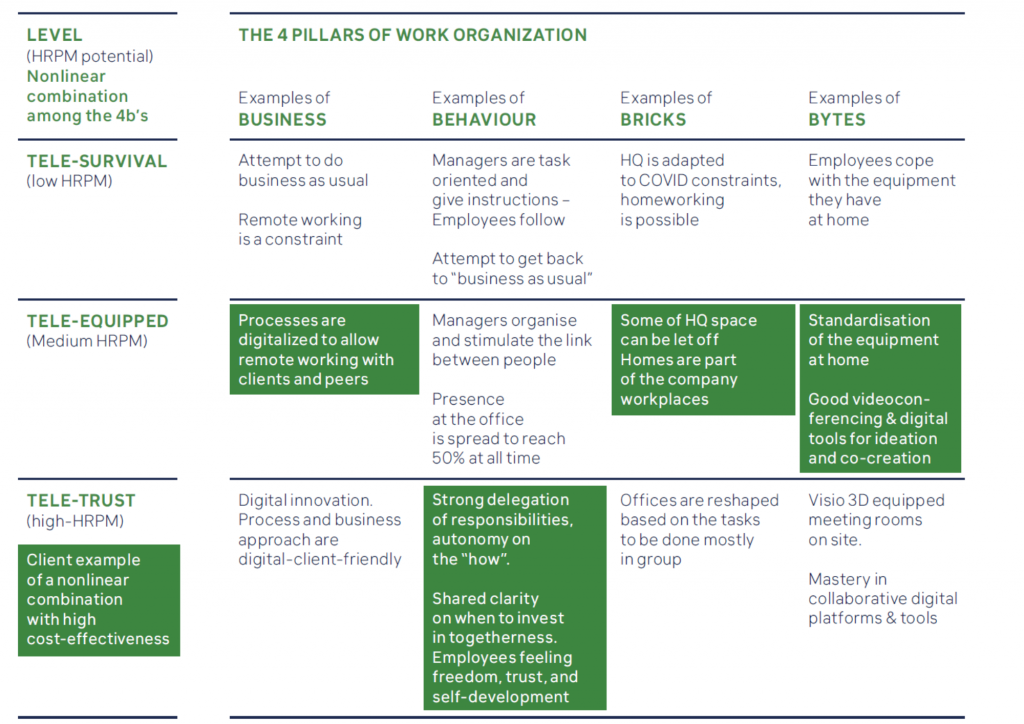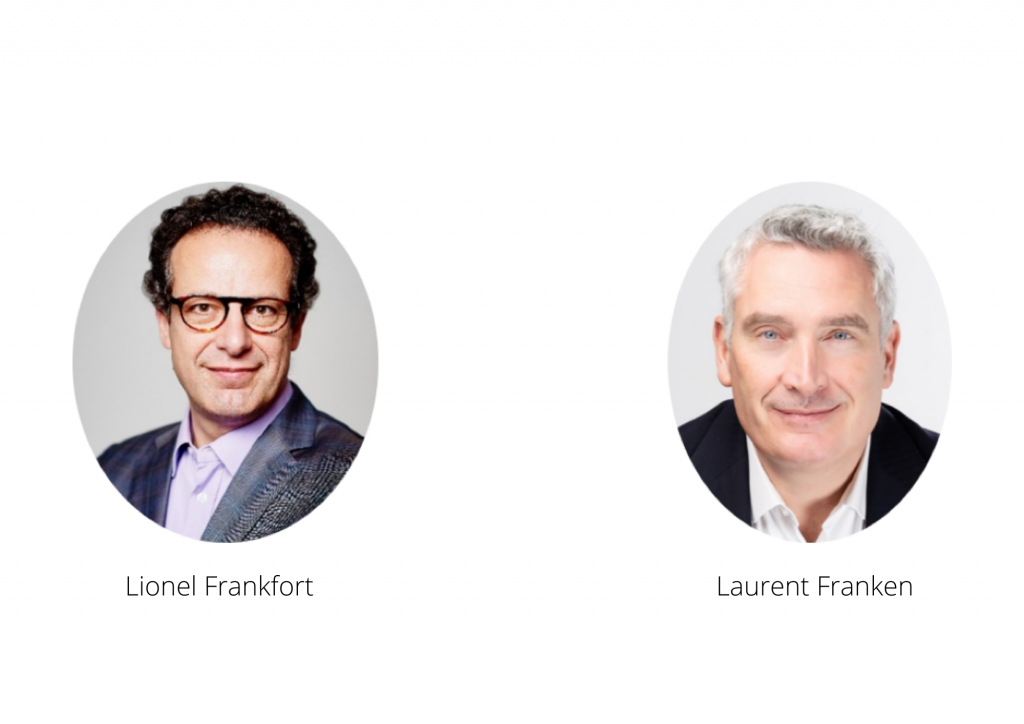Teleworking was imposed full scale on most businesses in 2020 and is a hot debate today. Analyses, evaluations and predictions have flourished since Spring 2020 on this topic. Whatever the merits of the views expressed, the question for us remains the following: what does it take, at a strategic level, to transform the experiments and lessons learned during the COVID forced teleworking into sustainable opportunities?
By opportunities, we mean that remote working (mixed with face-to-face activities) can lead to long-term and structurally embedded advantages, such as reinforced employee commitment and boosted business results. We believe this is a window of opportunity. Looking at firms that structurally used teleworking prior to the lockdown, we identified many instances where teams performed better. Since, we have seen that working from home promotes entrepreneurial initiatives, creates organisational agility, reveals, attracts, and helps retain talents – all these factors enhance revenues and profits.
Why should companies integrate remote working for good?
Despite these palpable benefits, there has been a tendency to approach the professional challenges thrown up by the COVID crisis as requiring companies to deviate from a norm (face-to-face working). Although the full telework-regime (forced by lockdowns) is mostly unsustainable, there is still a feeling that many companies would like to revert to old habits of mostly face-to-face, once they have weathered the storm.
However, there are some objective indicators suggesting that the time is ripe for a change, creating a remarkable opportunity for companies to rethink the way they work. Most employees have developed a taste for remote working and few are willing to go back full-time to the office (e.g. 34% in UK1). At the risk of stating the obvious, there is a definite combination of efficiency factors linked to teleworking: higher efficiency for personal work, lower travel cost, reduced travel time – which incidentally lowers the carbon footprint of employees –, better work-life balance and a higher trust in the manager-employee relationship.
However, there is a need to find the path to a new normal that will suit the specificities of the business, because there are also significant challenges attached to remote working. One of the main ones is to find ways to maintain social cohesion as a key factor to collaboration, performance and operational efficiency. Meeting on Zoom and similar platforms challenges group work around managing complexity, ambiguity, uncertainty and innovation. This is crucial both internally (among colleagues) and externally (with clients, suppliers and stakeholders at large). Another important challenge faced by companies is to find ways to reshuffle their product portfolio and sales & marketing operations in a manner suited to their remote communication and digital channels.
Our compass for developing your hybrid remote working identity: Integrating the Four B’s
Many factors play a part in determining the most appropriate remote working identity. For a company to strike the right balance, we advocate a conscious, integrated approach serving the company’s specific positioning and strategic challenges. This tackles the company culture and the way it should organise individuals and teams operating in a hybrid mix of face-to-face and remote work mode. We called this approach the Hybrid Remote-Presence Mode, HRPM in short.
Because it so defines the working culture of a company and is intimately linked with its business reality, this Hybrid Remote-Presence Mode could not derive from a one-size-fits-all. At best, companies could consider relying on best practices, but they will still need to adapt these to their environment.
Our model
To help a company determine its HRPM profile, we propose using an integrated model, looking at four pillars that are essential to the work organization in companies, the 4 Bs: Business (the work to serve your purpose and clients), Bricks (the company and remote premises), Bytes (the ICT tools) and Behaviour (the company culture and employee-manager relation)2.
The Hybrid Remote-Presence Mode profile of a company can be mapped by exploring the dimensions illustrated in the table below. It could be applied to a company’s current profile as well as to the profile the company and its employees aspire to have. Predictably, the higher the level of sophistication of a company in dealing with each of those pillars, the stronger its HRPM Profile will be. The table shows indicative examples for each pillar and a real case example with a nonlinear combination.

Our Method
In terms of method, we recommend building the current and aspired HRPM with the people that it will impact, by collaborating with key stakeholders, surveying and interviewing them. Structuring these conversations should not only improve the reliability of the outcome and generate ideas to adequately help close the gap between the “as is” and your aspired HRPM. These conversations are also a powerful way to trigger employees’ buy-in for the aspired HRPM. All four B’s should be addressed in a pragmatic way, using real-life experience and concrete aspirations.
The outcome of this process should help companies define the fittest Hybrid Remote-Presence Mode at an acceptable cost (see the client example above with a favourable cost-effectiveness). A possible scenario could require a company to broaden its offer of services to its clients or adapt its financial processes (Business). The company could very well be required to optimize its office space by turning the primary use of its offices into a socializing space for hybrid meetings and collaborative work (Bricks). The entire organizational dynamic would need to be adapted to ensure that individuals are placed in a position where they manage their work and hours in a coordinated fashion (Behaviours). For example, there may be a need for specific rules to clarify when teams should work remotely and when they should meet. Supporting tools should be adapted to enable asynchronous collaboration, hybrid meetings, the planning of tasks and the monitoring of projects (Bytes).
Defining and deploying your fittest working culture is a leadership and change challenge
Remote working is a great lever of performance, as long as it is well balanced with togetherness in the office in a way that fits your specificities. It has become essential and as such it should be assimilated, just as companies assimilated the use of fax machines or laptops in conducting their daily business. The journey to your best own Hybrid Remote-Presence Mode happens by engaging in meaningful conversations about these fundamental four B’s of your enterprise (wide scope) with many people (large scale). Making sense and creating a coordinated move on such a large scale and wide scope is a major leadership and change management exercise. It might be so challenging and even confusing that some leaders could fall back into the old normal, but we think that it is too late. COVID-19 has created such a precedent, even chaotic, that most employees and clients sense that it has a great potential beyond chaos.
We experienced that company culture and purpose are the most powerful levers to tackle the depth of the scope and the width of the scale of change. Culture and purpose are the glue for any human group. They are an asset, an accelerator and a guide to this journey to a new working identity, serving the business vision and strategy. We recommend you start experimenting because we know by experience that deploying a fittest Hybrid Remote-Presence Mode can boost well-being, engagement, and performance.
If you would like to further reflect on this topic, let’s set up a moment for a meaningful conversation together.
About the Authors

Besides their friendship, Lionel Frankfort and Laurent Franken share their passion for organizational change and corporate culture, each from different perspectives: Laurent approaches change through New Ways of Working / Real Estate projects whereas Lionel’s starting areas are strategic design and leadership.
In the current lockdown context, they have deployed their complementarities to give more sense to this major trend towards massive teleworking.
Lionel Frankfort is an expert in systemic organizational change towards more performance and harmony. His practice as coach-consultant in this field led him to run his consultancy LIFRAN (www.lifran.com) made of a network of fine professionals, helping leaders on several complementary fronts: strategy shaping, culture change, organizational design, and leadership development.
LinkedIn profile: Lionel Frankfort | LinkedIn
Laurent Franken supports companies in their transformation through work environment and real estate projects. He has been running Eiffel Services (www.eiffel.be) for 17 years, providing consulting services in the fields of: change management, New Way of Working design and implementation, management coaching, cultural and organisation audits.
LinkedIn profile Laurent Franken | LinkedIn
Download the PDF





